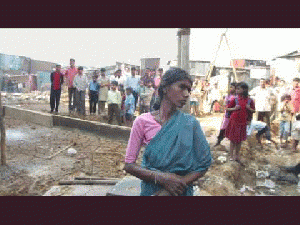Reprinted from Truthdig
The assault of global capitalism is not only an economic and political assault. It is a cultural and historical assault. Global capitalism seeks to erase our stories and our histories. Its systems of mass communication, which peddle a fake intimacy with manufactured celebrities and a false sense of belonging within a mercenary consumer culture, shut out our voices, hopes and dreams. Salacious gossip about the elites and entertainers, lurid tales of violence and inane trivia replace in national discourse the actual and the real. The goal is a vast historical amnesia.
The traditions, rituals and struggles of the poor and workingmen and workingwomen are replaced with the vapid homogenization of mass culture. Life's complexities are reduced to simplistic stereotypes. Common experiences center around what we have been fed by television and mass media. We become atomized and alienated. Solidarity and empathy are crushed. The cult of the self becomes paramount. And once the cult of the self is supreme we are captives to the corporate monolith.
As the mass media, now uniformly in the hands of large corporations, turn news into the ridiculous chronicling of pseudo-events and pseudo-controversy we become ever more invisible as individuals. Any reporting of the truth -- the truth about what the powerful are doing to us and how we are struggling to endure and retain our dignity and self-respect -- would fracture and divide a global population that must be molded into compliant consumers and obedient corporate subjects.
This has made journalism, real journalism, subversive. And it has made P. Sainath -- who has spent more than two decades making his way from rural Indian village to rural Indian village to make sure the voices of the country's poor are heard, recorded and honored -- one of the most subversive journalists on the subcontinent. He doggedly documented the some 300,000 suicides of desperate Indian farmers -- happening for the last 19 years at the rate of one every half hour -- in his book "Everybody Loves a Good Drought: Stories From India's Poorest Districts."
And in December, after leaving The Hindu newspaper, where he was the rural affairs editor, he created the People's Archive of Rural India. He works for no pay. He relies on a small army of volunteers. He says his archive deals with "the everyday lives of everyday people." And, because it is a platform for mixed media, encompassing print, still photographs, audio and film, as well as an online research library, it is a model for those who seek to tell the stories that global capitalism attempts to blot out.
"Historically, libraries and archive have been controlled by governments and by states," he said when we met recently in Princeton, N.J., where he is teaching at Princeton University for the semester. "They have also been burned by governments, states and regimes since before the time of the library of Alexandria. Secondly, archives have been the sites of major state censorship. You classify something you don't allow people to know. In medieval Europe and elsewhere, people resisted being documented. They didn't want to be part of the archive. They knew that recording and measuring their assets were the first steps toward seizing those assets for the ruling class. Hence, the idea of the people's archive that is not controlled by states, governments or other figures of authority. This is an archive people can access, people can create, people can build and authenticate. So the idea became the people's archive."
"It's not different from what I've done for 35 years as a journalist, especially my 22 years as a full-time journalist in India countryside," he said. "The big difference is that a digital platform allows me to do what I was doing earlier but on an infinitely larger scale and in collaboration with hundreds of other journalists. This site has two biases. One is labor, the work of people, how [the] nation and society rest on the backs of their labor. The second is languages."
Sainath's work is a race against time. He laments that in the past 50 years nearly 220 Indian languages have died. Only seven people in the Indian state of Tripura, for example, now speak the Saimar language. And it is not only languages that are going extinct. The diverse styles of weaving, the epic poems and tales told by itinerant story tellers, the folk dances and songs, the mythologies, the religious traditions, local pottery styles and rural trades such as that of toddy tappers, who scamper up 50 palm trees a day to drain the sap to make a fermented liquor called toddy, are all vanishing, leaving the world ever more impoverished and dependent on mass-produced products and mass-produced thought.
Sainath is determined to archive all of India's some 780 languages, many of them thousands of years old, spoken by 833 million rural Indians. He has amassed 8,000 black-and-white images of rural Indians. And he has sent filmmakers into villages to capture the deep humanity of the poor as they struggle to endure in a world that is increasingly hostile to their existence. For example, the archive website has a powerfully moving film about a 21-year-old dancer, Kali Veerapadran, titled "Kali: The Dancer and His Dreams." Raised in grueling poverty in a fishing village by his mother, the boy masters the Indian classical dance form known as Bharatanatyam and three ancient forms of Tamil folk dance (one of them perhaps 2,000 years old), and he makes his way to the country's leading dance academy and finally the academy's professional classical dance troupe. Online visitors can also see and hear five girls at a tiny and poorly equipped rural school sing, in English, the potato song.
Potato, Potato
Oh, my dear Potato
I like the potato
You like the potato
We like the potato
Potato, Potato, Potato
The first credit in each film on the site goes to the person whose story is being told, the second to his or her village or community and the third to the director.
Sainath's journal is not a romantic vision of the rural poor. He documents their darker side, the brutal caste system and feudalism that they live under, their bonded labor, their subjugation of girls and women, their prejudices. These conditions and practices, Sainath says, should die, but what is good, what gives people a sense of the sacred and a sense of who they are as individuals, has to be chronicled and protected.
"We are not there to adore the final product," he said. "We show you the labor process. Our potter is not someone sitting in the showroom talking to you. Our potter is a person down in the ditches after the rain digging for clay, on his hands and knees. You see him complaining about running out of clay as the real estate guys take over the area. You see we are running out of clay. We want you to respect that labor. In India labor is invisible. A lot is done by women. I shot a photo exhibition across 10 years called 'Visible Work, Invisible Women,' from 10 different states. It's the only photo exhibition in India that's been seen by over 700,000 people. Because I take it to the villages where it was shot. On the website we've digitized the entire exhibition. Each panel is two and a half minutes. You can watch a video and read the original text and the statistics. You can see the original photos in higher resolution. If you watch the video ... you will have me guiding you on a tour around the panel. You won't see me. You'll hear my voice. So you've got video, audio, text and still photo integrated. It's as close to the real exhibition as you can get online."
There are photos on the site of men on bicycles transporting 450 pounds of bamboo stalks.
"It's beyond me how he mounted them on the bike," Sainath said of one bamboo carrier. "But if you read the story, you'll see how he's done it. He has strengthened the cycle with bamboo. He has bamboo horizontal bars and bamboo vertical bars and he is supporting the big bamboos on them."
(Note: You can view every article as one long page if you sign up as an Advocate Member, or higher).






